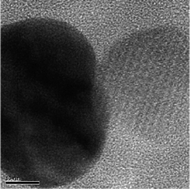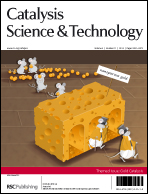CuAu/SiO2 catalysts for the selective oxidation of propene to acrolein: the impact of catalyst preparation variables on material structure and catalytic performance†
Abstract
CuAu/SiO2 catalysts are active and selective for the synthesis of acrolein from propene by selective oxidation using a mixture of H2 and O2 as oxidant. The catalyst synthesis method (impregnation or deposition) and the activation procedure (reduction, calcination or reduction followed by calcination and the choice of reducing agent) all affect the structure of the catalyst and therefore the performance in catalysis. For a material prepared by coimpregnation of HAuCl4 and Cu(NO3)2, reduction with hydrogen leads to a catalyst with a significant level of CuAu alloy, whilst reduction with NaBH4 solution leads to small particles but with negligible interaction between copper and gold. Subsequent high temperature calcination of these materials destroys any CuAu phase but retains a Cu–Au interaction as observed by Transmission Electron Microscopy. Preparation of the catalyst by a two-step deposition method gives smaller particles than coimpregnation when reduced by H2 but a different alloy phase is observed by EXAFS. Calcination of this material gives a catalyst which combines high activity with excellent selectivity to acrolein. Characterisation of the materials using various techniques allows the nature of the active sites to be understood.

- This article is part of the themed collection: Gold Catalysis

 Please wait while we load your content...
Please wait while we load your content...